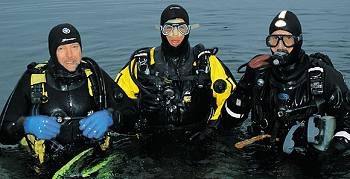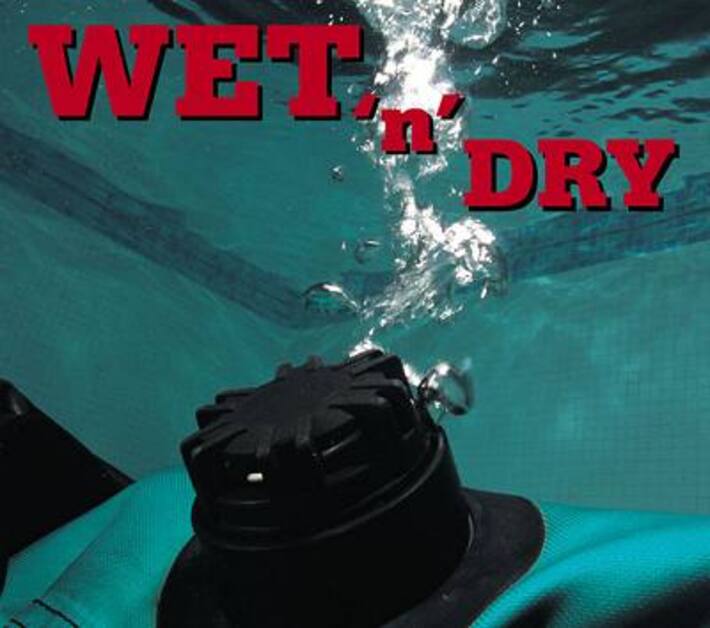A score of drysuits from which to choose, ranging from less than £400 to nearly £900 – but which ones offer best value for money?
John Bantin asked 20 manufacturers to provide an example of their single favourite product, and found three volunteers to take them under water.
Let their findings help you with your next purchase – but watch those zips.
FEBRUARY’S WEATHER DID NOT LET US DOWN. There was a winter’s chill about the lake at Wraysbury, mitigated only by a fine and perpetual drizzle.
A security alert at Heathrow meant that a band of police divers had been sent to check the lake for anything suspicious but they decided, by means of observations from within their steamed-up Land Rover, that the 4°C water probably didn’t harbour any terrorists.
What a perfect start to our latest comparison of drysuits.
Our Test Team
Who were the heroes who gave up their time to make eight extended test-dives each, in such unseductive conditions?
george buxton, a 56 year-old electrical engineer, is a BSAC First Class diver and Advanced Instructor, and an experienced trimix diver.
Gerry gooch, 47, is an engineer, 23 years a member of Hoddesdon SAC, once again a BSAC First Class diver and Advanced Instructor as well as an experienced trimix and closed-circuit rebreather diver.
Baby of the group was 38-year-old tim bradley, a sergeant in the Metropolitan Police and member of Hoddesdon SAC for 13 years.
He too is a BSAC Advanced Instructor, trimix-qualified and a keen CCR diver.

This group performed the task unstintingly, even with enthusiasm. They were as professional in approach as any diver could be expected to be.
They spent as much time as was needed performing all sorts of manoeuvres such as twists and body rolls to get as much information as possible on diving each suit.
They called on their experience of regularly diving deep wrecks off Britain’s coast to judge what makes a good suit.
If a drysuit’s primary function is to keep you dry, it is then a matter of selecting the correct thermally insulating undersuit to keep you warm.
Warmth is what we were particularly interested in during those days.
What else? You should be able to get the buoyancy-compensating air in and out of the suit without a second thought, be able to swim easily through the water wearing it and feel good about yourself when you’re inside it.
Durability can be hard to assess. Last time we embarked on such a drysuit comparison test, our test divers thoroughly recommended one make that took their fancy.
Half the members of their club bought examples. They all suffered leaks within the next 12 months.
Our test team was of the opinion that a tough trilaminate or Cordura suit would be more suitable for wreck-diving than a neoprene suit.
Other divers take the line that a neoprene suit continues to offer some insulation even if it gets punctured, so is better for wreck diving.
If you’re doing a lengthy trimix dive, you wouldn’t want to countenance a puncture in any suit. When it comes to durability, we can only make an educated guess.
We critically examined each suit, checking the construction, the finishing of the seams, the stitching and the way the boots and seals were fixed. The suits are described as tested.
Drysuit manufacturing is something of a cottage-industry, so manufacturers can offer many options for customising individual suits, sometimes at no extra cost.
Dry zips
In every case but one we thought that the weight of dry-zip fitted (8 pitch) was too light, especially for the heavier neoprene suits. We found only one suit supplied with a heavy-duty zip (O’Three).
Mediumweight zips might feel more comfortable in the shop, but will they last? Where heavy-duty zips (6 pitch) are an extra-cost option, we recommend them for anything but the simplest trilaminate suit.
Mike Hamilton-Scott of BDM, the dry-zip manufacturer, has said that some manufacturers of surface watersports suits are ignoring his company’s advice and using even lighter 10-pitch zips.
In many cases the zips were too short, which could stress them during dressing and undressing.
“Two extra inches would make all the difference,” was the unanimous verdict of our testers. Drysuit-makers should take note.
Among options available with some suits is the cross-shoulder or diagonal front-entry zip.
All three testers agreed that neither is truly “self-donning”, because even with the latter you invariably seem to need help to close the zip fully.
Valves
Revolving inflator valves make hose routeing easy, though some of those tested were fixed. We had requested shoulder-mounted constant-volume auto-dump valves.
Cuff dumps are simpler and a little less expensive but less suitable for divers who might be doing anything with their left hand, such as holding a camera, while under water.
A properly sited auto dump should be exactly that – automatic – despite what you might read posted by the misinformed on the www.divernet.com equipment forum.
Additional Features
We looked at additional features such as pockets and comfort flaps. We looked at knee pads and valves.
And, while still dry, we weighed each similar-sized suit to get a rough indication of the bulk. We noted how easily the test diver got into a suit before it was dived.
Each dive completed, the divers would regroup in the warmth of Wraysbury Dive Centre’s facilities and, reinforced with plenty of hot tea and freshly made sausage and egg sandwiches, would compare their first impressions with what they discovered under water.
Remarkably, no-one got a soaking.
Stock sizes or made-to-measure?
The fit of a suit was not considered because none of the test suits was actually made to measure.
However, because the divers were of similar dimensions, the suits were interchangeable and none really fitted less than well.
We believe that for a drysuit to be a successful purchase it must fit properly. If you are not a stock size, get your suit made to measure.
We used the hood supplied with each suit unless it proved too tight a fit, as was the case with the Coltrisub.
Latex or neoprene seals?
When ordering the suits, we specified latex neck seals wherever there was that option, simply because latex can be quickly adjusted to fit almost anyone.
Where fitted, we trimmed latex neck seals to fit. We measured the amount of contact between all the wrist seals and the wrist.
Neoprene neck seals need to be a good fit but our test divers each professed a preference for them, arguing that they last longer, are more comfortable, there’s no chance of any latex allergy, they are more resistant to puncturing and they don’t need replacing every year.
THE SUITS
| Price | Make/Model | Sizes | Material |
| £385 | Coltrisub Amphibian | MTM | Neoprene |
| £414 | Moby | MTM | Trilaminate |
| £465 | Beaver Iceberg Ultra | MTM | Compressed Neoprene |
| £499 | Scubapro Spitzbergen | Stock | Compressed Neoprene |
| £519 | RoHo Duratek | MTM | Cordura |
| £550 | Hammond | MTM | Cordura |
| £550 | Northern Diver Cortex DPD | MTM | Cordura |
| £550 | Polar Bears Discovery | MTM | Trilaminate |
| £550 | Procean Extreme | MTM | Procean |
| £563 | Otter Skin | MTM | Trilaminate |
| £572 | Poseidon Jetsuit TNG Technic | Stock | Neoprene |
| £585 | Aquion Pro | Stock | Trilaminate |
| £625 | Hydrotech Predator | MTM | Compressed Neoprene |
| £675 | Hunter Pro VSN 1100 Tek | Stock | Hunter |
| £685 | Oceanic Aerdura | Stock | Cordura |
| £685 | Waterproof Antarctic 2000 | Stock | Neoprene |
| £699 | Typhoon CNK Tech | MTM | Cordura |
| £700 | Body Glove | Stock | Neoprene |
| £872 | DUI CLX 450 | Stock | Cordura |
| £890 | O’Three Zeroth | MTM | Compressed Neoprene |

